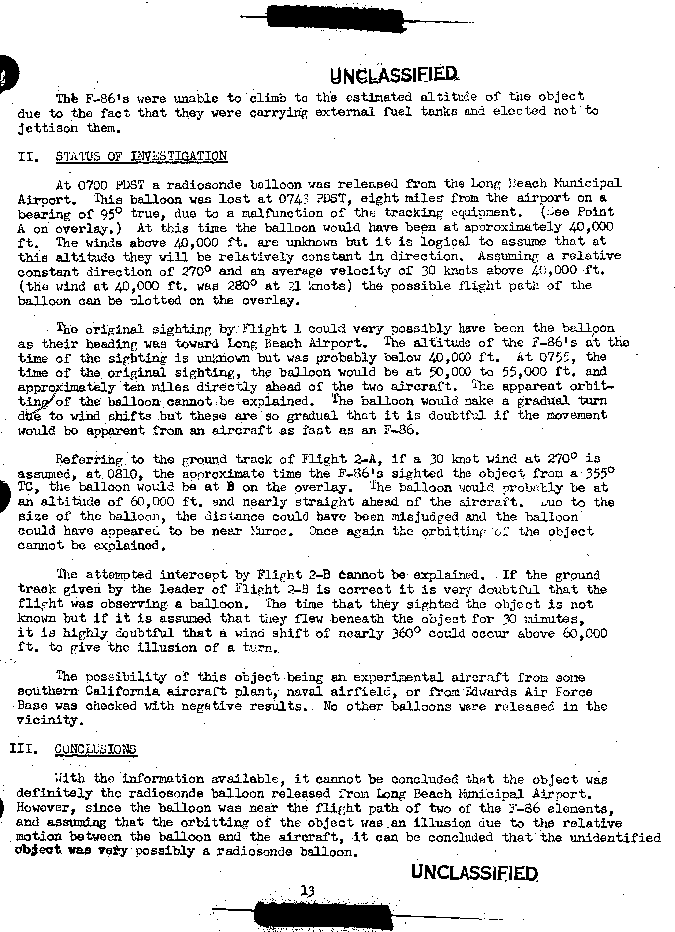1951
1 2 3 4 5 6 7 8 9 10 11 12 13 14 15 16 17 18 19 20 21 22 23 24 25 26 27 28

|
The F-86's were unable to climb to the estimated altitude of the objects due to the fact that they were carryinf external fuel tanks and elected not to jettison them.
II. STATUS OF THE INVESTIGATION
At 0700 PDST a radiosonde balloon was released from the Long Beach Municipal airport. This balloon was lost at 0743 PDST, eight miles from the airport on a bearing of 95° true, due to the malfunction of the tracking equipment. (See Point A on the overlay). At this time the balloon would have been at approximately 40,000 ft. The winds above 40,000 ft. are unknown but it is logical to assume that at this altitude they will be relatively constant in direction. Assuming a relative constant direction of 270° and an average velocity of 30 knots above 40,000 ft. (the wind at 40,000 ft. was 280° at 21 knots) the possible flight path of the balloon can be plotted on the overlay.
The original sighting by Flight 1 could very possibly have been the balloon as their heading was towards Long Beach Airport. The altitude of the F-86's at the time of the sighting is unknown but was probably below 40,000 ft. At 0755, the time of the original sighting, the balloon would be at 50,000 to 55,000 ft. and approximately ten miles directly ahead of the two aircraft. The apparent orbitting of the balloon cannot be explained. The balloon would make a gradual turn due to wind shifts but these are so gradual that it is doubtful if the movement would be apparent from an aircraft as fast as an F-86.
Referring to the ground track of Flight 2-A, if a 30 knot wind at 270° is assumed, at 0810, the approximate time the F-86's sighted the object from a 355° TC, the balloon would be at B on the overlay. The balloon would probably be at an altitude of 60,000 ft. and nearly straight ahead of the aircraft. Due to the size of the balloon, the distance could have been misjudged and the balloon could have appeared to be near Muroc. Once again the orbitting of the object cannot be explained.
The attempted intercept by Flight 2-B cannot be explained. If the ground track given by the leader of Flight 2-B is correct it is very doubtful that the flight was observing a balloon. The time that they sighted the object is not known but if it is assumed that they flew beneath the object for 30 minutes, it is highly doubtful that a wind shift of nearly 360° could occur above 60,000 ft. to give the illusion of a turn.
The possibility of this object being an experimental aircraft from some southern California aircrcaft plant, naval airfield, or from Edwards Air Force Base was checked with negative results. No other balloons were released in the vicinity.
III. CONCLUSIONS
With the information available, it cannot be concluded that the object was definitely the radiosonde balloon released from Long Beach Municipal Airport. However, since the balloon was near the flight path of two of the F-86 elements, and assuming that the orbitting of the object was an illusion due to the relative motion between the balloon aand the aircraft, it can be concluded that the unidentified object was very possibly a radiosonde balloon.